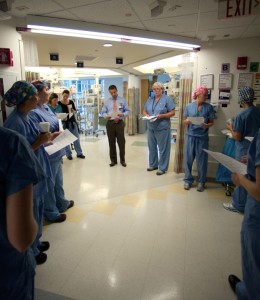However, this assessment has not been conducted in children’s hospitals—until now.
In a study in the Journal of Nursing Administration, nursing leaders from 38 free-standing children’s hospitals explored which nursing and organizational characteristics influence mortality for children undergoing congenital heart surgery.
The study, involving 20,407 pediatric patients and 3,413 pediatric critical care nurses, was led by Patricia Hickey, PhD, MBA, RN, from the Heart Center at Boston Children’s Hospital.
In pediatrics, congenital heart disease is the most common birth defect requiring surgical intervention for survival. Due to their critical care needs, these patients consume a disproportionate share of U.S. hospital resources.
“The hardest challenge is getting this right—and improving mortality rates—for the sickest patients, particularly these types of pediatric cardiac surgery candidates,” says Hickey.
Mortality in the CICU was significantly greater when one-fifth or more of the RNs had two or fewer years of clinical experience.
The researchers collected data for the years 2009 and 2010. Of the 38 children’s hospitals, 97 percent were academic teaching hospitals with a cardiac surgery volume of at least 50 cases over two years. The hospitals’ senior nursing leaders were invited to complete an electronic organizational assessment survey. (To develop the survey content, Hickey first led a series of conference calls with cardiovascular nurses and scientists from these hospitals to solicit their expert opinions about what nursing and organizational characteristics are important to improving congenital heart surgery outcomes.)
The survey examined several domains of nursing, including RN staffing; nursing education; specialty certification; overall clinical experience; critical care unit experience; indirect resources provided for nursing support; physician-type roles; and hours of coverage.
Experience and training count
Of the nurses studied, 71 percent held a baccalaureate degree in nursing. Fifty-two percent had five or fewer years of nursing experience and 48 percent had more than five years. Also, 62 percent had five or fewer years of specific nursing experience in the intensive care unit (ICU). Fifteen percent were professionally certified in either critical care (13 percent) or pediatric nursing (2 percent).
Of the 20,407 patients, 59 percent were less than 1 year of age, and 55 percent were male. The in-hospital mortality for the national cohort was 2.7 percent.
More years of nursing experience significantly improved patient outcomes and independently decreased in-hospital mortality.
The odds of death significantly increased when the percentage of RNs with two or fewer years of clinical experience was 20 percent or more. When this percentage exceeded 25 percent, the odds of in-hospital mortality increased by a factor of 1.52.
Importantly, years of ICU experience alone did not predict mortality, but total clinical experience was a significant factor. “This finding may reinforce the notion that experiential knowledge and skill acquisition is cumulative over time regardless of the clinical setting, as professional nurses advance their practice,” the study authors wrote.
As the institution-wide percentage of critical care nurses with at least 11 years’ clinical experience increased, the odds of in-hospital death decreased.
More nursing education also was associated with decreased odds of death for children undergoing cardiac surgery, as was participation in national quality metric benchmarking.
Mission critical
Overall, the nursing leaders found significant variation in the structures and processes to support ICU nurses and broad differences in mortality rates for congenital heart surgery patients, ranging from 0.0 percent to 5.1 percent across the 38 hospitals.
Based on their findings, they recommend that pediatric ICUs should have no more than 20 percent of their staff with less than two years’ experience.
“We believe ongoing attention to the proportional mix of experience level of pediatric critical care nurses needs careful scrutiny by unit and hospital leadership,” Hickey notes. “Because it saves the lives of critically ill children, we are recommending a proportion cut-point.”
However, she stresses the importance of bringing new graduate nurses into these units as well, as long as they are supported through orientation and mentorship for two years. “For the future of pediatric critical care, we are obligated to have a pipeline of properly experienced, educated nurses. These findings also reinforce the need for retention strategies to ensure experienced nurses remain in the critical care environment.”
“Although it has been speculated that nursing experience does matter, this is the first known study to demonstrate that it actually does matter in pediatric nursing,” the study authors concluded.







